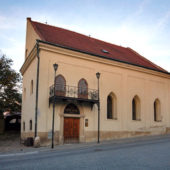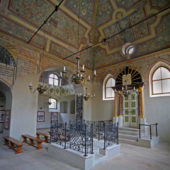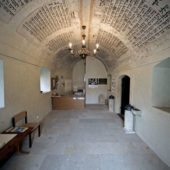The Boskovice synagogue is a superb and lovingly restored remnant of the city’s once thriving Jewish community.
The Boskovice Synagogue is a superb and lovingly restored remnant of a once thriving Jewish community that for centuries played a prominent role in the life of this town in southern Moravia. The earliest records indicate some Jewish presence in Boskovice as far back at the 13th century, but it wasn’t until 1639 that work began on the synagogue. Confined by law to reside in a ghetto, Boskivice’s Jews hired Italian builder, Sylvestr Fiota, to build the synagogue to meet the needs of their growing population. Using a relatively simple plan in a neo-gothic style, Fiota created a synagogue sturdy enough to endure for centuries.
Soaring above the main hall, the synagogue’s vaulted ceiling is supported by massive walls one meter thick. The two-story structure also features a women’s vestibule on the main floor while the upper floor includes three galleries. The ark is located on the east side of the building, typical of European synagogues. The simple elegance of the building itself is complemented by brilliant frescoes adorning the walls and ceiling vaults. Between 1657-1667, two Polish Jews, Mordecai of Cracow and Meir of Zulz decorated the synagogue in a traditional eastern European style with rich floral and plant ornamentation along with Jewish symbols such as the menorah, the Temple in Jerusalem and other images from Jewish folklore and literature. Hebrew scripture, poems and dedications are interspersed throughout the synagogue’s walls and ceiling.
In the late 17th century, the synagogue was expanded to accommodate the community’s increasing population. Boskovice’s Jewish community reached its zenith in the mid 19th century when restrictive laws against Jews were largely repealed. However, with the onset of Zionism in the early 20th century, Boskovice’s Jewish population slowly began to dwindle. The Nazi occupation led to the deportation of the remaining 600 Jews to Terezin concentration camp and the synagogue became a warehouse for property taken from the Jews. After the war, only 12 Jews returned to Boskovice. When this tiny Jewish community disbanded, the synagogue fell out of use and eventually became a storage facility. In the late 1980s, interest in the synagogue revived and a 13-year restoration process ensued, funded by the synagogue’s owner, Brno’s Jews, the Czech government, the World Monuments Fund, and other groups. The synagogue reopened in 2002 and today, thanks to its exquisite paintings, stakes its claim as one of the Czech Republic’s most important examples of synagogue decorative art.
For more information see http://www.wmf.org/project/boskovice-synagogue



